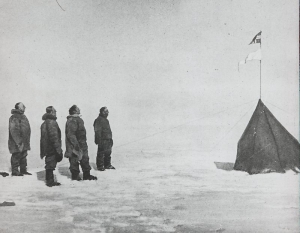Did you know that some traces Roald Amundsen left in Antarctica can still be seen?
On a continent that is 98% solid ice it isn’t easy to leave tracks, but there are 80 cultural heritage sites on the official list of historic places and mounuments in Antarctica, and 11 of them are Norwegian.
 The tent Roald Amundsen left at the South Pole is a protected cultural heritage site – but nobody now knows exactly where it is. Photo: Norwegian Polar Institute
The tent Roald Amundsen left at the South Pole is a protected cultural heritage site – but nobody now knows exactly where it is. Photo: Norwegian Polar Institute
On 6 January 1912, the Norwegian polar explorer Roald Amundsen raised a cairn on Mount Betty (Queen Maud Range) in Antarctica. He and the rest of his expedition team were on their way back to Framheim after having reached the South Pole.
Mount Betty, or Betty’s Peak, was named after the nanny who cared for Roald Amundsen when he was a boy. The cairn is associated with one of the major events in the exploration of the world’s last uncharted regions. Roald Amundsen left a letter and a tin of paraffin in the cairn. The letter was later retrieved and in 1987, Monica Kristensen mounted a commemorative plaque on the cairn.
On 3 December 1911, the Norwegian Kristian Prestrud raised a cairn on Scott Nunatak (Queen Alexandra Range). Prestrud participated in Roald Amundsen’s Antarctic expedition in 1911 but was not a member of the group that reached the Pole. Rather, he was leader of an expedition that explored large tracts of the continent north and east of Framheim, in the as yet uncharted Edvard VII Land.
The tent Roald Amundsen’s party pitched at the South Pole 14 December 1911, and which appears in the iconic photograph of Amundsen and his men at the Pole, is a protected historic monument. Today nobody knows exactly where the tent is, but we are certain that it is far under the surface of the ice, which is constantly moving. The tent was left behind at the South Pole with a letter to Kong Haakon and a greeting to Amundsen’s competitor Robert F. Scott. The Englishman Scott and his men found the tent when they arrived at the Pole over a month after Amundsen. They too left the tent standing. Since then, the Norwegian researcher and polar adventurer Monica Kristensen has tried twice to find the tent – both in 1986–1987 and 1993 – but without success. The tent is the only artifact on the official list of cultural heritage sites in Antarctica for which the location is unknown.
The Norwegian Polar Institute is the Norwegian authority in charge of management of cultural heritage sites in Antarctica, with expert guidance from Directorate of Cultural Heritage.